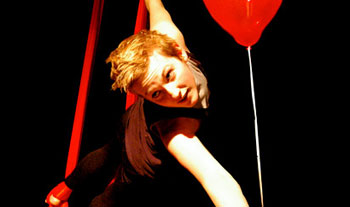
The Philadelphia Shakespeare Theater
Directed by Carmen Khan
(April 7 – May 9, 2010)
Love can be dreamlike. One minute, it’s sure as a compass; the next it’s completely transformed into doubt and confusion. One minute, lovers feel lighthearted, skipping around the room as if clutching pink balloons; the next, lovers may feel bereft and confused. In the Philadelphia Shakespeare Theater’s production of William Shakespeare’s A Midsummer Night’s Dream, the company captures that ephemeral quality of love, with a pared-down performance in the round.
One of the challenges of translating a Shakespearean comedy is that many of the verbal jokes no longer make immediate sense. When paired with physical humor, however, these jokes make audiences not just understand but roar. Such was the brilliance of this production: making Shakespeare’s lines come alive.
On a nearly empty stage hung two sets of red trapeze silks, tied securely to the ceiling and used for various purposes (tying a character up, climbing or concealment). This “tissue work,” as it’s known, lends a circus air to the production, helping to create a place of fantasy. Similarly, the prelude, sung by Puck in an Asian-inspired mask, introduces the idea of a dreamlike landscape, as Puck distributes pink balloons to the cast, who react with amazement and wonder.
This season calls for great versatility amongst the company, as most of the actors appearing in the airy MND also performed in one of Shakespeare’s darkest plays, Macbeth. That versatility is embodied by the actors who played Theseus (Ron Heneghan, who played Macbeth) and Hippolyta (Christie Parker, who played Lady Macbeth), doubling as the king and queen of the faeries, Oberon and Titania. As the humans Theseus and Hippolyta, Heneghan and Parker play their roles as upright and controlled. However, as fairy royalty, they are capricious and childlike.
Just as the Philadelphia Shakespeare Theatre’s production of Macbeth borrowed from Asian music and theater forms, MND is inspired by Indian music, movement, and costuming. For a western audience, this creates a world far different from current depictions of fairies while better embodying the original place of fairies in European mythology. While today, fairies are primarily seen as beautiful and harmless, traditional perceptions included a sense of danger and darkness.
So, for example, when Titania dances, instead of emulating ballet, with graceful pointed toes and smoothly-flowing arms, she pokes her toes up, thrusts her limbs and makes striking facial expressions: both beautiful and, at the same time, fearsome.
Costumes also borrow from Indian styles, with banded collars for the male courtiers (which also happens to be a current style, so that it both updates the look and evokes an Indian feel) and a stylized sari for Hermia (Kate Russell). Titania and Oberon wear facial jewels, and Oberon’s coat looks very much like the princely raiment of Indian royalty.
Puck in this production is performed by a woman, Mary Tuomanen. Instead of costuming her as an androgynous, Peter-Pan-type character, costume designer Vickie Esposito put her in a very animal-like suit: with stripes and long, false breasts, complete with a multicolored, straw-like wig and raccoon-like circles painted around her eyes. Her look, in combination with Tuomanen’s controlled movements, make Puck appear to be either an Asian-inspired monster or a very primal human being.
Like Titania, Puck is more than just a mischievous sprite in this production. At times, she is playful; at others, almost frightening because of her unearthly ways. Her exceptional timing in delivering her lines adds humor even to such throwaways as “I’m here.”
The runaway crowd favorites amongst the cast were Kathryn Raines as Helena and John Zak as Bottom, both of whom are skilled at physical humor. Helena’s teary, over-the-top pursuit of Demetrius (Chris Braak) evoked laughter and sympathy (after all, who hasn’t found themselves, at least emotionally, in a similar situation of unrequited love?). Bottom’s prating self-confidence is reminiscent of the late Don Knotts, who was similarly fearless about using facial expressions and body language to make himself look silly in the pursuit of a laugh.
The production was pared down to about two hours of total running time: two one-hour acts with an intermission in between. Yet, it felt like nothing was missing. Upon comparison with the original play, this adaptation removed several preambles and passages of exposition, as well as making all the fairy parts non-speaking. This kept the focus on the main characters and helped expedite the plot. These changes also make the play more accessible for a modern audience.
Fortunately, they did not trim the production by Bottom and his craftsmen cohorts, a play within a play that was one of the highlights of the production, as the audience roared at the craftsmen’s bumbling efforts.
The Philadelphia Shakespeare Theatre captures the capriciousness and dreamlike quality of love, creating a fantastic or mythical space through careful attention to body language, music, and lighting. All of these factors bring A Midsummer Night’s Dream vividly alive for a modern audience.
Rating: **** (4 out of 4, Must See)
Note: While the theater is in the second floor of an older building, and exiting is not permitted during the play due to the actors’ frequent use of the main theater entrance, accommodations for the handicapped or those with special concerns can be made ahead of time by calling the box office.
Disclosure: The author received complimentary admission to the theater for this production.

